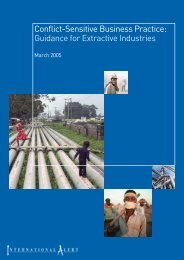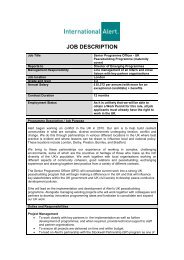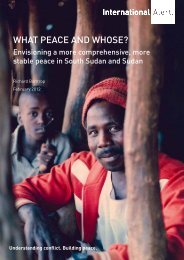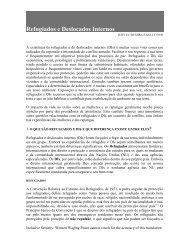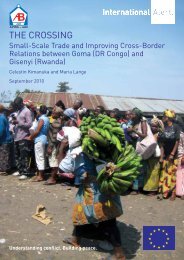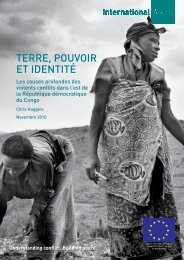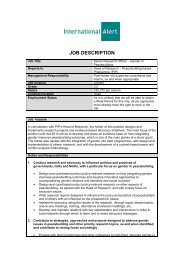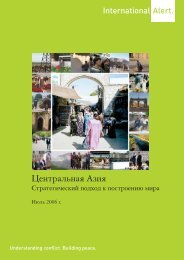40 • Women’s Bodies as a Battleground: Sexual Violence Against Women and Girls During the War in the Democratic Republic of CongoMost of the problems mentioned in Table 12 are damaging to women’s reproductive health, and this isparticularly significant as the majority of the women interviewed are of childbearing age. Leucorrhoea(heavy periods), for example, immediately suggests the presence of a sexually transmitted infection. Dysuria(difficult or painful urinating), pains in the lower abdomen, and irregular periods can also all be symptomsof vaginal infections. These medical conditions can lead to primary sterility in women who have never givenbirth, or secondary sterility in those who have already had at least one baby. This is because, if they do notreceive appropriate treatment in time, the infection can travel up the vagina and uterus and infect and blockthe Fallopian tubes, thereby rendering fertilisation almost impossible and thus compromising the women’sfuture childbearing prospects. The same is true for prolapse of the womb and for vaginal tearing, whichrequires surgical repair, especially in the case of women of childbearing age.Urine and faeces flowing from the vagina are signs of vesico-vaginal and recto-vaginal fistulas, which alsoneed surgical intervention. Women suffering from this have to wear sanitary towels constantly or in mostcases, because of the poverty in which most of them live, just a piece of cloth, which they have to washfrequently. Women with vaginal fistulas often live apart from the rest of the community, because of the badsmells that they give off. One victim described the effects of this:“Since I was raped, I’ve had water permanently running down between my legs. I haveto wear a piece of cloth that I must wash five to seven times a day and this means havingwater and soap available. Sometimes when I am in company, I see the others get up oneafter the other, or else their mood changes suddenly, they cut short the conversation andleave as fast as they can. Then I realise that I’ve begun to give off… and I go home towash myself and to shut myself up in my hut, to hide my shame.”Most of the victims do not fully understand the extent or gravity of the health problems and complicationsthat leucorrhoea and vaginal discharges can cause, and they try to conceal them from their husband and theirfamily. This situation only serves to deepen their distress, because they need medical help and the moralsupport of those close to them.It has not been possible within the framework of this survey to determine the number of women in thesample who are infected with HIV/AIDS. However, it is estimated that nearly 60% of combatants involvedin the war in the DRC are HIV-positive, 55 which means that there is a high risk of infection. It is known,moreover, that the risk of HIV/AIDS being transmitted during forced and violent sexual intercourse is muchhigher than in the case of consensual intercourse. Genital injuries, including tears and scratches to the vaginaor to other organs, increase the probability of transmission if the attacker is HIV-positive. Also, theprotective vaginal secretions that are present during normal sexual intercourse are absent in the case of rape.Girls who have not yet reached puberty run a high risk of HIV infection, in that they are more liable thanolder girls and adult women to suffer vaginal injuries during rape.At the Saint Paul health centre in Uvira, the research team read the medical records of 658 women who hadbeen raped between January 2002 and February 2003. On the basis of the results of clinical examination,493 women received treatment. Of these, 121 failed to respond to the initial treatment, which meant theyhad to be given broad-spectrum antibiotics to deal with the infection.Of the victims who were examined and treated at this health centre, the overwhelming majority presentedwith two or three sexually transmitted infections and these cases had be treated with the use of severaladditional antibiotics. The main diseases found in these patients were gonorrhoea, primary syphilis, softchancre, genital herpes, vaginal bubo, vaginal trichomonad, HIV/AIDS. The graph on the next page showsthe percentage of women affected by these various diseases. 5655.Human Rights Watch, La guerre dans la guerre, op. cit., p.62.56.This figure was drawn on the basis of data obtained from an activity <strong>report</strong> of the Saint Paul centre in Uvira, covering the periodfrom December 2002 to February 2003.
41 • Women’s Bodies as a Battleground: Sexual Violence Against Women and Girls During the War in the Democratic Republic of CongoHIV 9%cervicitis 4%soft chancre 7%vaginitis 7%endometriosis 7%vaginal trichomonad 7%genital scabies 4%pubic tinea 9%gonorrhoea 31%syphilis 13%leucorrhoea 2%Graph 2: Medical problems diagnosed in 658 women rape victims who were patients at the Saint Paul health centre in UviraNine per cent of the women who were tested for HIV/AIDS turned out to be HIV-positive. These resultsare probably not an accurate reflection of the real situation, given that techniques for taking bloodsamples in the rural areas are not entirely reliable, and that the tests were carried out on the patients onlyonce, between December 2002 and February 2003. The incubation period for HIV can be as long as ayear and therefore the test ought to be carried out several times, the last test taking place one year afterthe suspect sexual contact. It is only at that point that a reliable diagnosis can be made.The majority of the rape victims – 70% of the women interviewed – had received no medical treatment at all.Some had decided not to go to a health centre, preferring not to reveal what had happened for fear of beingstigmatised. Others could not get access to treatment, either because there was no health centre in their area,of if there was, because it was too far from where they lived. The roads were unsafe, and many women wereunwilling to set out alone, for fear of being attacked and raped again. Some of the interviewees had beenrobbed and stripped of their belongings after being subjected to rape, and were totally without financial meansand incapable of meeting any medical expenses, or of getting themselves to a specialised clinic in a town.The destruction of much of the public health infrastructure poses many problems. A large number of hospitalsand rural health centres have been completely looted and ransacked and have had to close. Medical staff havequit their jobs because of the lack of security, rapes, abductions and pillaging. In the most remote rural areasthe lack of competent nursing staff means that victims have little chance of receiving proper medical care. Thefew health centres in the rural areas that are still functioning are not equipped to deal with the morecomplicated cases. In urban centres such as Bukavu the general hospital and the clinics are stretched beyondtheir capacity and are unable to properly deal with all the cases presented to them.More than half of all the medical facilities in South Kivu suffer from a dire shortage of medicines, to thepoint that they are no longer able to give their patients even basic primary care. Shabunda, for example,has 66 health centres, of which only 34 are functioning – and this only since 2001. There are only twogeneral practitioners in post for the whole area. The 34 functioning centres have experienced interruptionsin the supply of essential medicines since the outbreak of the war. Only ten of them receive emergencymedical support, from Médecins sans Frontières Holland.A number of local organisations also look after victims of sexual violence and 18.6% of the womeninterviewed had benefited from their support. These associations arrange first aid for the the victims





